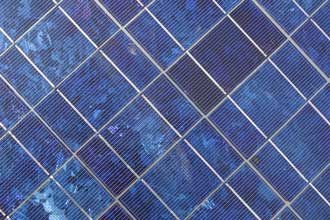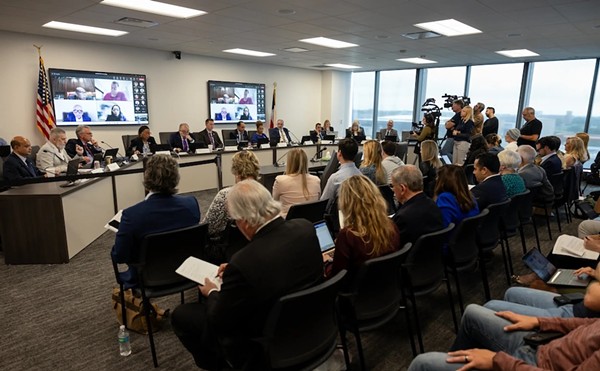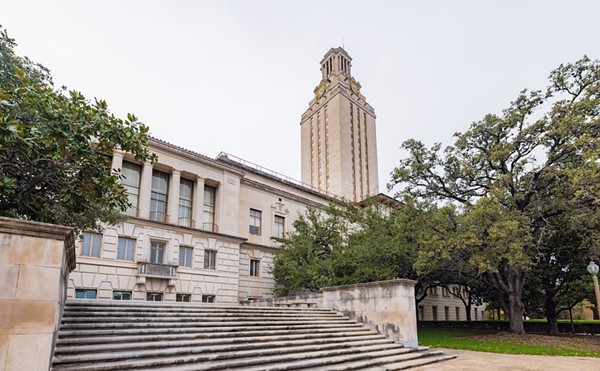| No, not crop squares made by aliens, these are solar panels. |
It turns out that deflecting the sun’s rays from parked cars is only a happy by-product of the structure’s real purpose, which is to convert solar energy into power. Unwittingly, I had parked under a section of the imaginatively named Solar Power Station #1. Handsomely designed by local architect Stephen Colley, and completed for $300,000 in November 2003, it is a collaborative project of CPS Energy, UTSA, and Solar San Antonio. The station’s 198 photovoltaic modules can produce in ideal conditions upwards of 10 kilowatts of power, the amount three standard homes daily consume.
However modest its output, this stand-alone project — like CPS’ solar-powered Northside Customer Service office on San Pedro Avenue — demonstrates the efficiencies to be gained from producing on-site energy, or what CPS calls “distributed generation.” This process stands in sharp contrast to the industry’s historic reliance on massive central-power plants, such as the coal-fired facilities on Braunig and Calaveras lakes, that route energy to consumers through a dense grid of substations sited within and high-wire transmission lines that crisscross over our neighborhoods. With solar, we can create a new kind of built environment, reduce harmful emissions, and scrub clean the sky.
For San Antonio, that tantalizing prospect may be a long way off. That’s in part because CPS Energy is in the business of selling kilowatt hours, producing an enviable record of generating low-cost energy. But when I asked architect Colley why CPS was not employing its conservation fund to systematically construct, for example, solar-power stations in our open-air parking lots, he responded that CPS doesn’t seem to have figured out how to make money via conservation or alternative fuels. Until it does, it will likely continue to invest in technology and infrastructure more suited to the 20th Century than to the 21st.
Austin Energy, by contrast, has one of the most aggressive energy-conservation programs in the country, consistent with the city’s ambition to be the “Clean Energy Capital” of the world. In late July, the mayor and city council announced plans to rewrite building codes to ensure that all new-home construction will meet Zero-Energy Capable standards; under these guidelines, an Austin Energy press release notes, each house “will be energy-efficient enough to be a net-zero energy home with the addition of on-site energy generation, such as solar photovoltaics. This level of energy efficiency is approximately 60 percent more efficient than homes built to code today.”
To encourage owners to upgrade older properties, Austin Energy provides a bundle of carrots. Wary of plunking down $6,000-10,000 to install a one-kilowatt (1,000 watts) solar system? Don’t be: there’s a $4-per-watt rebate defraying $4,000 of your costs. Want a nifty, $3,500 solar-powered water heater? Knock almost 50 percent off the sticker after rebates (up to $650) and tax credits (up to $1000) kick in. Increased insulation, better weather stripping, and more-efficient air-conditioning systems qualify for a 20-percent rebate. The philosophical underpinning to this multi-faceted program is simple: “The cleanest of all energy,” declares Austin Mayor Will Wynn, “is the energy that doesn’t need to be produced.”
I don’t doubt but that Mayor Phil Hardberger and CPS Energy share Mayor Wynn’s conviction. But providing serious financial incentives to underscore why we must be more energy-smart apparently is another matter. Yes, 4 percent of CPS’s energy comes from renewable sources (but you pay a premium for Windtricity); yes, it offers an $80 rebate for an electric-powered lawnmower (but only on purchases made between March and June); and, yes, there is a rebate for Energy-Star central-air-conditioning systems, provided funds are available (this year, the program’s pot was expected to be depleted by Labor Day weekend).
But type “solar” into the CPS Energy-website search engine and you get “No Results.” Can the city-owned utility really be as blind to the future heralded in its Solar Power Station #1 as I was ignorant of that facility’s true function? If so, that’s a bad sign.
Char Miller is professor of history and director of urban studies at Trinity University. He is author of Deep in the Heart of San Antonio: Land and Life in South Texas, and editor of On the Border: An Environmental History of San Antonio.



















